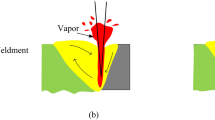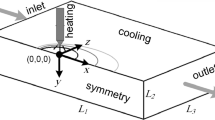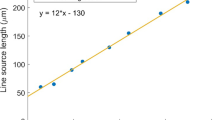Abstract
Melting and solidification behaviour in the deep penetrution welding process is different from that in conventional welding process in deep penetration processes there is keyhole formation and the full thickness of the plate receives the are heat input unlike conventional processes in which the heat input is received only by the surface nodes. In the present study, the thermal analysis of molten pool formation and solidification keyhole welding using plasma are welding has been done using the finite element method. The model accounts for the several phenomena associated with welding, like the distributed are heat input over the top surface and along the thickness, the temperature-dependent material properties. convection and radiation heat losses etc. The analysis is performed for different combinations of parameters. viz welding current and welding speed, which have the maximum influence on molten pool shape and solidification behaviour. The model has also been validated by conducting experimental measurement of thermal cycles experienced by the plate for different welding parameters. The weld pool dimensions. viz. the length and widlh are found to increase with inincreasing current and decereasing welding speed. Thermal cycles at locations close to the weld reach a higher value of temperature and the time for peak temperature is also less but at farther locations the peak temperature reached is lower and the time for peak temperature is higher. Details of the model, the experimental results obtained and the solidifications charateristics of the pool are discussed in this paper.
Similar content being viewed by others
References
Ananthan S S 1989A study on the effects of parameters and development of Keyhold monitor for plasma keyhold welding. M S thesis, India Institute of Scicence. Bangalore
Asbu E K Jr. Kikuchi N, Jallad A R 1989 Experimental finite element analysis of temperature distribution during are weldingTarns ASME J. Eng. Mater. Technol, 111: 9–18
Friedman E: 1975 Thermomechanical analysis of welding process using finite element methodTrans. ASME J. Pressure Vessel Technol, 97: 206–213
Giedi W G 1986 Heat transfer and fluid flow in electron beam welding.Proc. Conference on Trends in Welding Research in USA (ed) S A David (New Orleans, LA: Am, Soc. Metals) pp 109–128
Goldnk J. Bibby M. Moore J. House R. Patel B 1986 Computer modelling of heat flow in welds.Metal Trans. B17: 587–600
Knitz G W, Segerland I. J. 1978 Finite element analysis of welded structures.Welding J. 57(7): 211–216
Lambrakos S G 1995 Simulation of deep penetration welding of stainless steel using geometric constrants based on experimental informationProc. 4th Int. Conf on Trends in Welding Research (eds) H B Smart, J A Johnsan S A David Sponsored by ASM Ind. and Am. Welding Soc., pp 45–50
Mazumder J Steen W M 1980 Heat transfer model for CW laser material processingJ. Appl. Phys. 51: 941–947.
Metealfe J C. Quigley M B C 1975 Heat transfer in plasma are welding.Welding J. 54: 99–103
Ravichandran G. Ananthan S S 1998 Analysis of thermal cycles during plasma are welding by finite clement methodWelding Rex. Inst. 19(2) 57–63.
Swifthook D T Gick A E F 1973 Pentration welding with lasers.Welding J. 52: 492s-499s
Tcknwal P. Stitt M. Mazumder J. 1987. Finite element modeling of heat transfer in gas lengsten are weldingMetal Conxtructior 19: 599–606
Zucharia T. Bjerke M A. Simunovic S 1993 High performance computing for materials process modeling Int. conf. on Modeling and Control of Joining Processes (ed) T Zachuria cosponsored by American Welding Society and Oak Ridge National Laboratory, pp 27–35.
Author information
Authors and Affiliations
Corresponding author
Rights and permissions
About this article
Cite this article
Ravichandran, G. Solidification behaviour in plasma are welding. Sadhana 26, 199–211 (2001). https://doi.org/10.1007/BF02728486
Issue Date:
DOI: https://doi.org/10.1007/BF02728486




